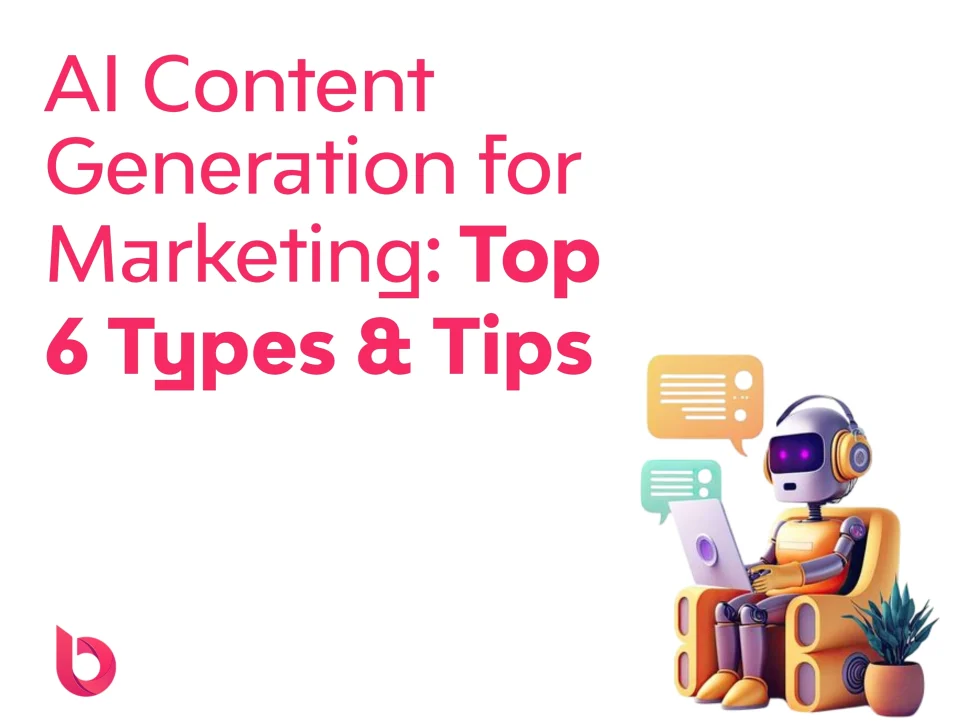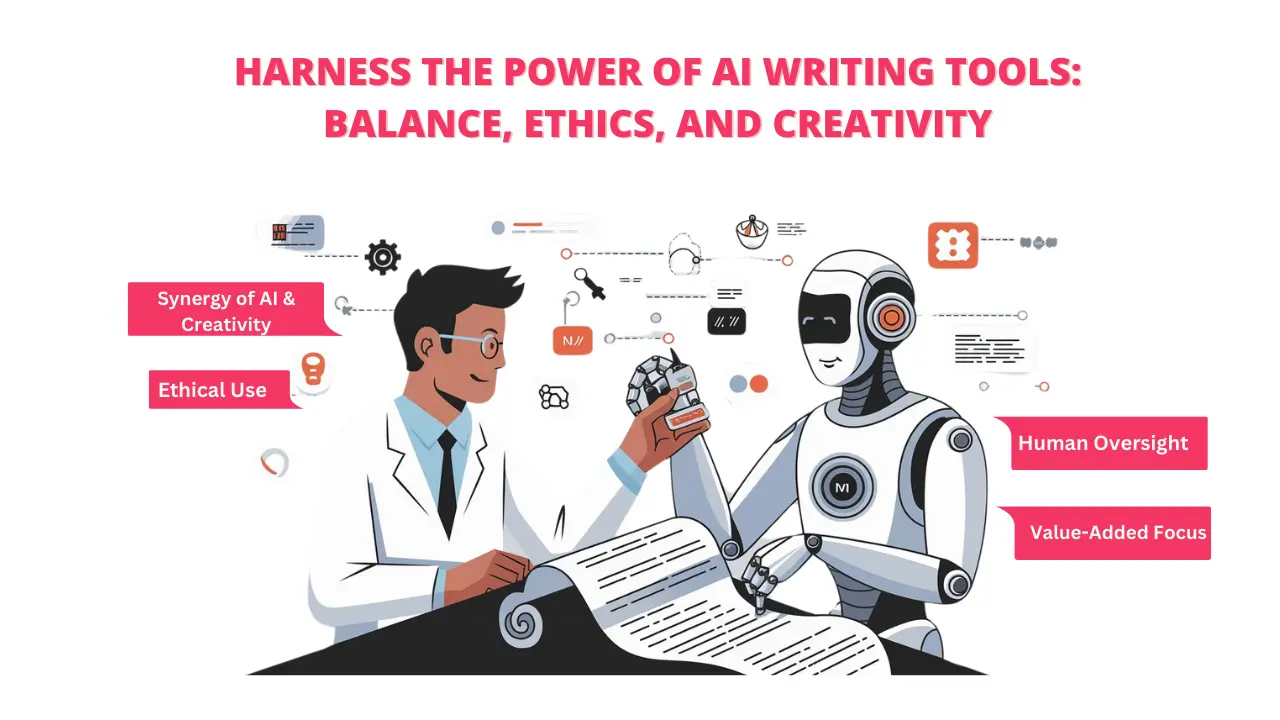Today, around 85% of marketers are using AI tools to improve their content strategies.
This new technology has sparked a significant transformation in content creation by helping businesses create more content quickly while keeping it high-quality and personalized.
This shift is happening because the demand for content has skyrocketed to an unprecedented level!. Marketers must create engaging posts for different platforms, and traditional methods take too much time.
AI content generation for marketing solves this problem by allowing businesses to create more high-quality content efficiently, making the most of their resources while keeping their brand voice intact.
In this guide, you’ll learn how AI is changing content marketing, the best AI tools for different types of content, and useful tips to use AI in your strategy effectively.
What is AI Content Generation?
Definition and Concept
AI content generation means using artificial intelligence tools to create text, images, or audio automatically. These tools use machine learning, data analysis, and natural language processing (NLP) to produce content that sounds like it was made by humans.
AI content generation systems study large amounts of existing content to understand language patterns. They then create new content that matches a brand’s style and marketing goals.
How AI Content Generation for Marketing is Revolutionizing?
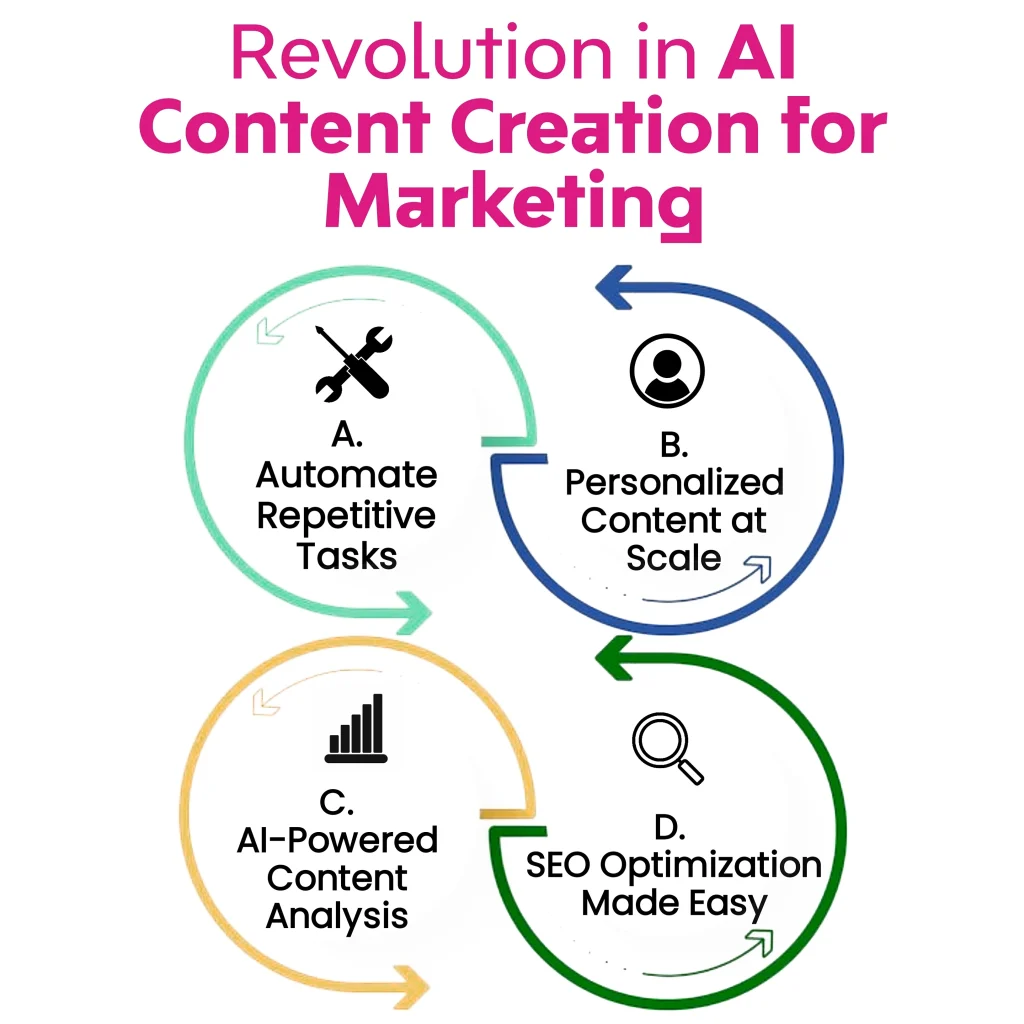
Unlike traditional content creation, which takes a lot of time and effort, AI can generate drafts, different versions, or even complete content pieces in seconds. This helps businesses to:
- Automate repetitive writing tasks
- Create personalized content on a large scale
- Auto analyze data to improve content quality
- Easily optimize content for SEO and better engagement
Common Myths About AI Content Generation
- AI will take over human writing – AI helps speed up content creation, but human creativity is still important.
- AI content is always low quality – If used correctly, AI content generation can create well-written and customized content with great assistance, with tools like Blogi.
- Only big companies can afford AI – Many AI tools have budget-friendly options for small businesses and freelancers.
Why AI Content Generation Matters Now
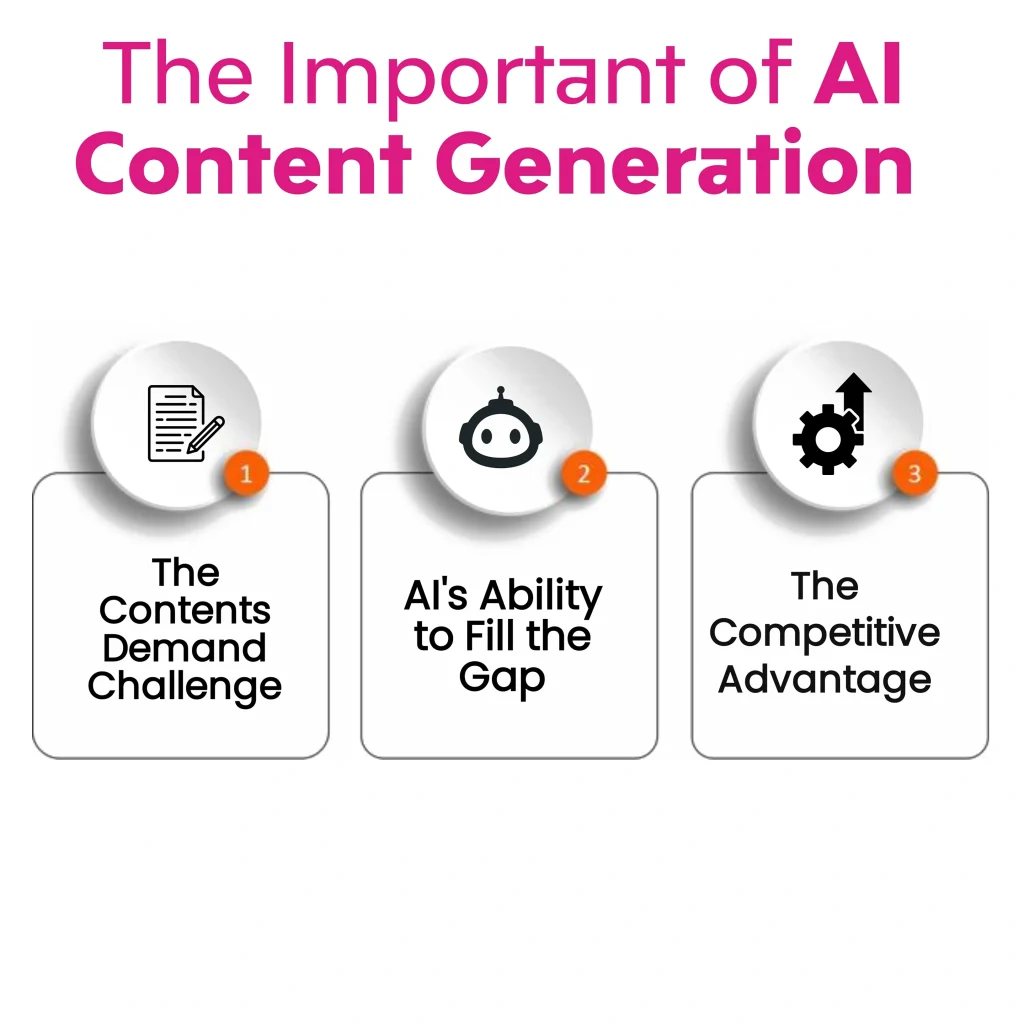
➕The Content Demand Challenge
Marketers today face a bigger challenge than ever—keeping up with the rising demand for content. Studies show that businesses now create four times more content than they did five years ago. This is because of the increasing number of platforms, reducing attention span of viewers and the expectation for more personalized content.
This demand creates major challenges for marketing teams:
- Different platforms need different types of content (social media, emails, websites, videos, podcasts).
- Consumers expect content that matches their interests and behavior.
- Regular updates are necessary to keep content current.
- Businesses must compete harder to stand out online.
➕How AI Bridges the Gap
This gap between rising demand and constrained capacity is filled by AI by:
- Routine content creation tasks can be automated
- Cutting down on the time needed for preliminary drafts
- Enabling cross-channel content repurposing
- Offering insights based on data for optimizing content
➕ The Competitive Advantage
Businesses that start using AI content generation for content early are already seeing big benefits. Companies that add AI to their content process have reported:
- 49% more content created
- 37% lower content costs
- 27% better audience engagement
Compared to traditional methods, AI helps businesses work faster, save money, and connect better with their audience.
Top 6 Types of AI Content Generation for Marketing
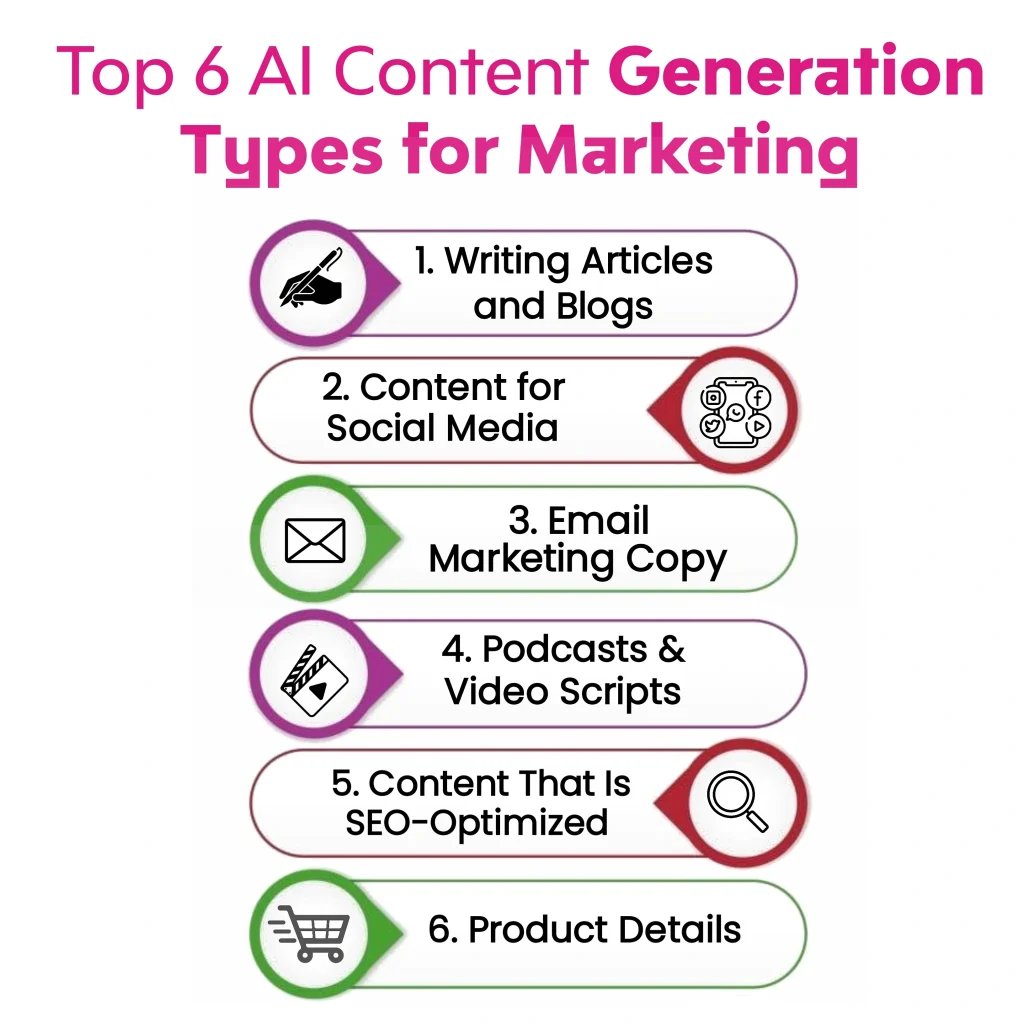
1. Blog Writing & Articles
AI content generation tools that specialize in long-form content can help writers overcome writer’s block, create outlines, come up with ideas for headlines, and create entire blog posts.
Top AI tools:
- Blogi – Finds trending topics and creates high-quality blog posts.
- AI Collective – Create text and visuals using multiple AI models optimized for SEO.
- CopyAI – Great for generating creative blog ideas and outlines.
Real-world example:
A marketing agency, Digiboost, used AI content generation to create first drafts for blogs, allowing human writers to refine them. This increased client blog production by 300% and led to a 42% rise in organic traffic.
Reasons to Use It: Accelerates the production of content while providing SEO recommendations and adaptable writing styles.
2. Social Media Content
AI content generation solutions are able to produce social media posts tailored to a particular platform, produce different captions, and recommend the best hashtags based on popular subjects.
Leading tools:
- Lately – Turns long-form content into multiple social media posts.
- Sprinklr – Uses AI to suggest content based on audience insights.
- Engagi – Helps manage replies and boost engagement to grow social media presence across all major platforms.
Real-world application: Fashion brand StyleSavvy used AI content generation to customize social media content for different audience groups. This led to a 78% increase in engagement and a 23% boost in conversions from social media traffic.
Reasons to Use It: Maintains consistent social media activity without compromising brand voice.
3. Email Marketing Copy
AI email tools can craft subject lines, develop email body content, and personalize messages based on recipient data.
Leading tools:
- Sendster – Generates full-length newsletters and subject lines while helping collect leads.
- Mailchimp AI – Suggests and improves email copy.
- Persado – Creates emails with emotional appeal using audience insights.
Real-world example:
Software company CloudTech used AI-generated subject lines, increasing open rates by 32% and click-through rates by 26%.
Reasons to Use It: Increases email open and click-through rates by using optimized, engaging copy.
4. Video Scripts & Podcasts
AI content generation can develop video outlines, generate dialogue, create storyboards, and transcribe/summarize audio content.
Leading tools:
- Vidscribe – Transcribes, translates, and dubs videos using AI.
- Synthesia – Generates AI video presenters with custom scripts.
- RunwayML – Provides AI-powered video editing and generation.
Real-world example:
The educational platform LearnFast reduced video production time by 65% using AI to draft scripts and create storyboards, helping them launch courses twice as fast.
Reasons to Use It: It saves time on video production while maintaining high-quality scripts.
5. SEO-Optimized Content
These specialized AI content generation tools examine top-performing content and make optimization recommendations to improve search visibility.
Leading tools:
- Blogi – Creates content with SEO-friendly titles, meta descriptions, and guidelines.
- NeuralText – Generates optimized content with built-in research features.
- MarketMuse – Helps plan and optimize content based on topic authority.
Real-world example:
The e-commerce site HomeGoods grew organic traffic by 156% in six months by using AI to find content gaps and optimize product pages.
Reasons to Use It: Increases content visibility and ranking on search engines.
6. Product Descriptions
AI product description generators have the ability to generate compelling, unique descriptions on a large scale, which is especially useful for e-commerce businesses.
Leading tools:
- AI Collective: Specializes in e-commerce copywriting with the help of multiple AIs.
- Jasper: Provides product description templates exclusively.
- Anyword: Makes performance predictions for various copy variations.
Real-world example:
Online marketplace VendorCentral reduced product listing time by 80% and increased conversion rates by 24% using AI-generated product descriptions for 15,000+ products.
Reason to Use It: Engaging and optimized copy increases conversions on product pages.
How to Make Effective Use of AI for Content Generation for Marketing
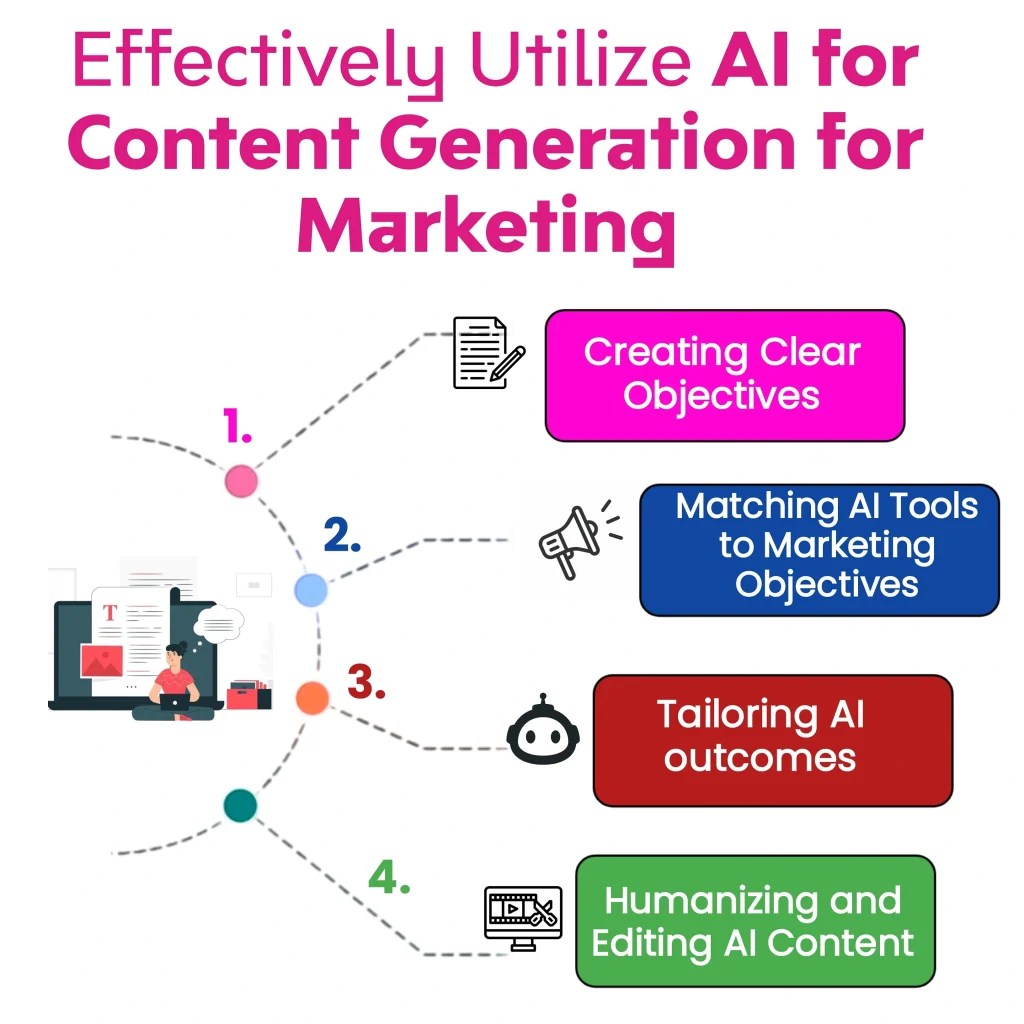
A. Establishing Clear Objectives
Determine your goals before using artificial intelligence. Ask yourself:
- What content problems do I need to fix?
- How will I measure success? (More traffic, saved time, better engagement?)
- How will content generation fit into my current workflow?
Common objectives, for instance:
✔ Get more blog visitors
✔ Increase social media engagement
✔ Personalize email marketing
Using AI tools like Blogi, which combines multiple AI models, can help create fresh and unique content for these goals.
B. Aligning AI Tools with Marketing Goals
Different AI content generation tools work better for different tasks. Choose the right one based on your marketing goals:
| Marketing Goal | Recommend AI Focus |
| Brand awareness | AI for social media posts, blog topic ideas |
| Lead generation | AI for landing pages, emails, gated content |
| Customer retention | AI for personalized emails, product suggestions |
| Conversion optimization | AI for A/B testing, product descriptions |
C. Tailoring AI Results
The secret to unique AI content generation is proper customization:
- Teach AI the voice of your brand: Give instances of your top-performing content using Blogi or similar tools.
- Create detailed prompts: Include tone, audience, objectives, and constraints
- Generate brand-specific templates: Allow for AI flexibility while standardizing formats.
- Use custom knowledge bases: Provide AI tools with proprietary information and industry expertise.
D. Editing and Humanizing AI Content
Even the most sophisticated AI requires human refinement. Establish a consistent editing protocol:
- Fact-check all assertions and statistics
- Add personal insights, experiences, and case studies
- Enhance emotional resonance and storytelling elements with tools like Blogi.
- Incorporate original research and proprietary data where applicable
Many top businesses follow the 70/30 rule—they let AI create 70% of the content and then add 30% of human touch to make it unique and trustworthy.
Benefits of AI in Content Generation for Marketing
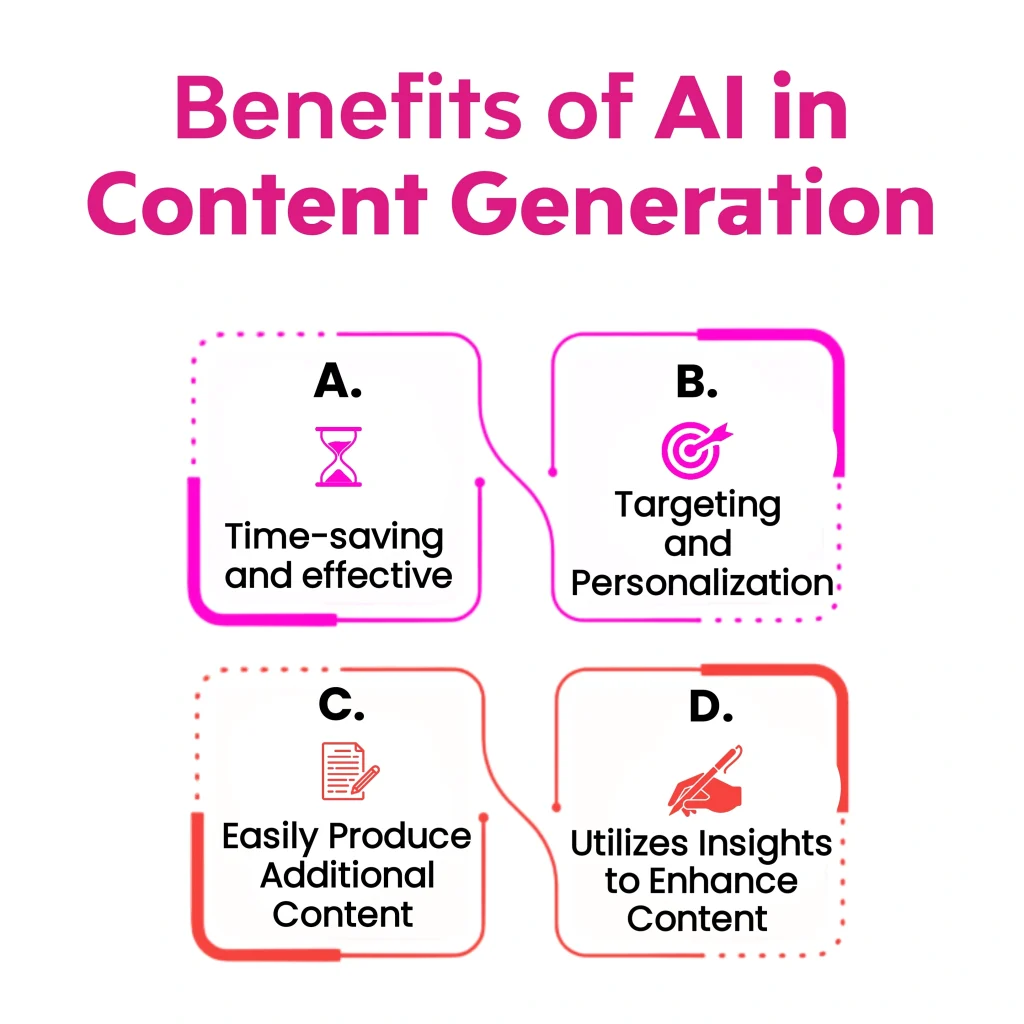
1. Efficiency and Time-Saving
The most immediate benefit of AI content generation in marketing is the dramatic reduction in time required for content production:
✔ First drafts take 80–90% less time compared to manual writing.
✔ Research is 65% quicker, allowing for fast information gathering.
✔ SEO and formatting tasks are 72% faster with AI tools.
2. Personalization and Targeting
AI is excellent at producing customized content variations according to audience segments:
✔ Changes tone and message based on buyer personas.
✔ Creates location-based content.
✔ Personalizes content for different customer journeys.
✔ Generates multiple versions for A/B testing.
3. Easily Create More Content
AI enables marketing teams to significantly increase content output.
✔ Expands into new platforms without extra workload.
✔ Keeps posting schedules consistent across different channels.
✔ Quickly translates and adapts content for different countries.
✔ Easily creates seasonal or promotional content.
AI implementation enables enterprises to support 3-5x more content channels, allowing for business growth without increasing marketing headcount.
4. Uses Data to Improve Content
AI content platforms provide valuable feedback loops:
✔ Finds topics and formats that get the most attention.
✔ Identifies words and phrases that increase engagement.
✔ Measures how different audiences react to content.
✔ Compares AI-written vs. human-written content.
Tips for Implementing AI Content Generation for Marketing
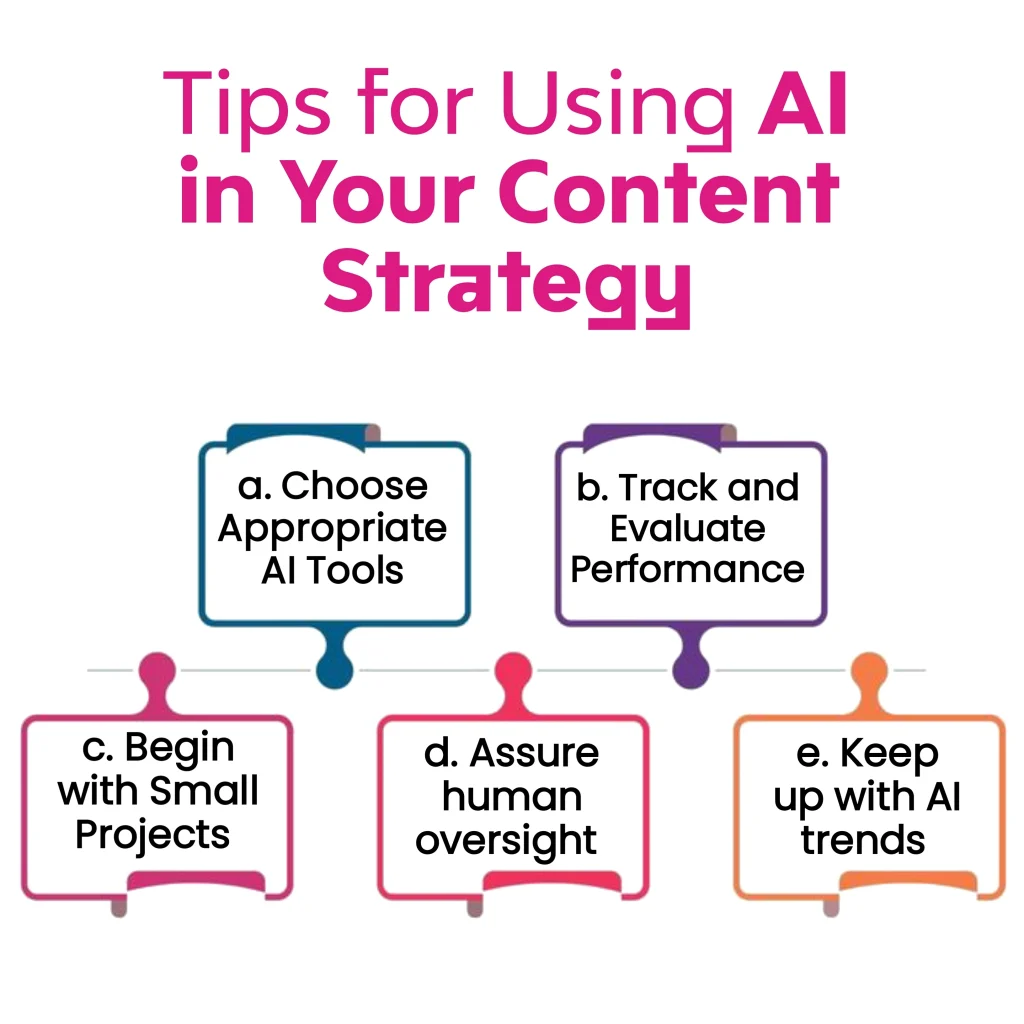
1. Select the Right AI Tools.
There are many AI tools available, so choosing the right one can be tricky. Keep these in mind:
✔ Check if the tool works with your current software.
✔ See if it’s easy to learn and use.
✔ Compare pricing with how much you’ll use it.
👉 Example: Pick AI tools based on what you need—blog writing, social media posts, or SEO.
2. Monitor & Analyze Performance
Keep an eye on how AI-generated content is performing.
✔ Compare AI content with human-written content.
✔ See if AI helps you save time and resources.
✔ Check audience engagement and feedback.
✔ Monitor SEO rankings and conversions.
👉 Example: Change your AI content strategy based on what gets the most engagement.
3. Start with Small Projects
Start your AI content journey with limited, low-risk implementations.
✔ Try AI for short content like social media captions.
✔ Use it for internal documents or idea brainstorming.
✔ Test AI-generated email subject lines.
👉 Example: Use AI for product descriptions or email subjects before scaling up.
4. Ensure human oversight
AI can help, but human review is still needed to keep content high-quality.
✔ Make sure AI follows your brand’s tone and values.
✔ Set clear guidelines for reviewing AI-generated content.
✔ Use a scoring system to check consistency.
✔ Have an approval process, especially for important content.
👉 Example: With tools like Blogi, you can refine AI content while keeping it aligned with your brand.
5. Stay Updated on AI Trends
To stay ahead of the competition, remain aware of new developments.
✔ Try new AI tools to see if they work better.
✔ Join AI communities to learn best practices.
✔ Form a small team to explore AI innovations.
✔ Have a process for testing and adding new AI features.
👉 Example: Experiment with the latest AI tools to get even better results.
Conclusion
AI is changing the way marketing teams create content. Instead of replacing human creativity, AI helps with routine tasks, giving marketers more time to focus on strategy, storytelling, and making real connections with people.
When used effectively, businesses can save time and effort while producing more content, improving message personalization, reacting to trends more quickly, and forging stronger bonds with their customers. Tools like Blogi AI Writer gather information from different sources and create fresh, original content to keep your blog up-to-date and relevant.
Combining human creativity, strategy, and emotion with AI’s speed and data-driven accuracy is where the true power lies. This isn’t just about keeping up—it’s about leading the conversation.
So, are you ready to fully utilize AI’s capabilities and transform your content game? Do not fall behind—the future of marketing is here.

